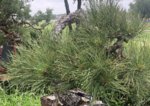I have been having weird damage problems from critters recently - and I never had them in the past.
Last year I was having problems with tree rats munching on my smaller Chinese elm buds. No other part of the tree - just the buds. I placed traps in the area and haven't seen any damage in the last six months. (I'm not using the slang term for squirrels - in SoCal tree rats are actually a "thing").
Now I am having a problem with a small bird(s) snipping off leaves from one of my larger (6' tall) field elms that I am growing out to increase trunk caliper. Not eating them - just snipping them off one side of the upper part of the tree. Little bastard comes in early morning almost pre-dawn hours, and attacks my tree... leaving a little pile of leaves around the base of the trunk. I have moved the tree and hopefully the bird will decide to go elsewhere.
I don't think the damage in this case is caused by an animal. I don't have a clue what is causing it, but my first guess would be some sort of insect. It doesn't look like whatever is causing the damage is eating the needle, unless it is puncturing the needle to get the sap(?) I don't think it is fungus, because I assume the damage would be less specific and more widespread. These are little pinpoints of damage.

? Have known this since childhood. Never have called conifer pitch "sap".

